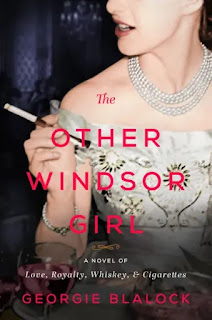Georgie Blalock is the author of the new novel The Other Windsor Girl, which focuses on the life of Britain's Princess Margaret. She also writes under the name Georgie Lee.
Q: Why did you decide to focus on Princess Margaret in
your new novel?
A: I focused on Princess Margaret because she is such
a fascinating character. She had it all but, as a member of the Royal Family,
she didn’t truly have the freedom to enjoy it.
Also, postwar England is an interesting time of
transition when a little of the old world of Downton Abbey still existed before
swinging ‘60s London wiped it away for good. The change from one world to
another, the loss of old traditions and a way of life, and the uncertainty and
possibilities that those changes created offered a great deal of complex
conflict to explore.
Q: What did you see as the right balance between the
historic Princess Margaret and your own fictional version?
A: Princess Margaret gave me so much material to work
with but she is still my fictional character.
I did my best through research to understand her and
her world but I didn’t allow the strict historical record to become a
constraint. I wanted the freedom to give her life my own interpretation, to
adjust timelines, people and events and invent characters and conversations to
meet the needs of a story.
At the same time, I strove to give it the proper feel
and impression of the era. I think I found a good balance between my story
about two women trapped by the circumstances of their lives who strive to
create the life they want and the real Princess Margaret.
Q: How did you come up with the character of Vera
Strathmore?
A: Vera came to me as a way to give readers an
outsider’s view of what it was like to be a part of the Royal Family in the
1950s. Since she isn’t a part of that world, she has the readers’ same sense of
wonder and discovery when she gets a peak behind the royal curtain. She is an
amalgamation of the many real people who wrote books or left memoirs about
their time with Princess Margaret.
Her position as second lady-in-waiting to Princess
Margaret gives Vera a taste of glamour and respect but it comes at the price of
personal sacrifice, and insight into the less regal side of royalty. In the
end, the once overlooked Vera must decide whether she wants fame by association
or a life of her own making.
It was fun to have her be able to make choices about
the direction of her life that Princess Margaret never had a chance to make.
Through Vera, I offer readers a new take on how the events of Princess
Margaret’s life might have played out.
Q: What kind of research did you do to write the book,
and did you learn anything that especially surprised you?
A: I did a great deal of research on Princess
Margaret’s life and times by reading any biography or article that I could find.
I also read biographies about people who would have
been contemporaries of my characters so I could get a sense of what it was like
to live in England in aristocratic society in the 1950s. I often use real
events from historical people’s lives to make my fictional heroes and heroines
more realistic.
What surprised me most about Princess Margaret was her
relationship with the press. I’d always thought that the press hounding royals
is a modern phenomenon but it isn’t. They loved her and she used them to remain
in the public eye.
Later in life, she would call reporters that she
trusted and feed them details about her life. She craved and loved attention
and she found creative ways to get it.
Q: How would you compare the scrutiny Princess
Margaret faced with that of younger members of the royal family today?
A: The press’ current treatment of the royals is
similar to the way Princess Margaret was treated. Princess Margaret was the
Princess Diana of her day. She was beautiful, glamorous and everyone wanted to
know everything about her.
During her 1949 trip to Italy, a reporter snuck into
her hotel room and reported on what color nail polish she used. On that same
trip, the press used telephoto lenses to snap pictures of her swimming in a
pale bikini in Capri. They then wrote that she was swimming naked.
Even Life magazine in their May 16, 1949 issue ran
this story. If you Google it, you can read it. I think it shows that there is
nothing new when it comes to the press’s intrusive relationship with the
royals.
Q: What are you working on now?
A: My next novel is tentatively titled The Last
Debutante. It centers on Valerie de Vere Cole, daughter of the famous prankster
Horace de Vere Cole and the niece of Neville Chamberlain.
It follows her during her 1939 London debutante
season, the last glittering one before the start of World War II. Her unique
position as a deb and a resident of No. 10 Downing Street gives her a
distinctive view of the world at that moment in time and the coming war.
Q: Anything else we should know?
A: Thank you so much for having me on your blog and
for reading The Other Windsor Girl. I hope readers who love The Crown, royalty
and English history enjoy my novel.
--Interview with Deborah Kalb


No comments:
Post a Comment